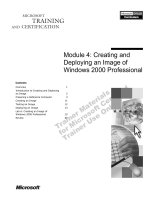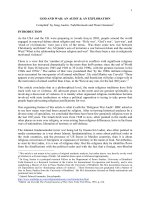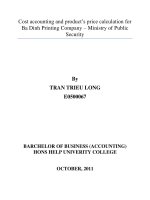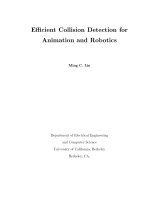Guidance for Planning and Conducting an Audit of Internal Controls of Public Debt docx
Bạn đang xem bản rút gọn của tài liệu. Xem và tải ngay bản đầy đủ của tài liệu tại đây (367.88 KB, 56 trang )
ISSAI 5410
The International Standards of Supreme Audit Institutions, ISSAI, are issued by the International
Organization of Supreme Audit Institutions, INTOSAI. For more information visit www.issai.org
Guidance for Planning
and Conducting an
Audit of Internal
Controls of Public
Debt
I N T O S A I
INTOSAI Professional Standards Committee
PSC-Secretariat
Rigsrevisionen • Landgreven 4 • P.O. Box 9009 • 1022 Copenhagen K • Denmark
Tel.:+45 3392 8400 • Fax:+45 3311 0415 •E-mail:
I N T O S A I
EXPERIENTIA MUTUA
OMNIBUS
PRODEST
EXPERIENTIA MUTUA
OMNIBUS PRODEST
INTOSAI General Secretariat - RECHNUNGSHOF
(Austrian Court of Audit)
DAMPFSCHIFFSTRASSE 2
A-1033 VIENNA
AUSTRIA
Tel.: ++43 (1) 711 71 • Fax: ++43 (1) 718 09 69
E-MAIL: ;
WORLD WIDE WEB:
Public Debt Committee
Chairman
Gregorio Guerrero
Contador Mayor de Hacienda de México
Members
Argentina
Enrique Paixao, Emilia Raquel Lerner
Auditoria General de la Nacion
Canada
Jeff Greenberg
Office of the Auditor General
USA
Paul Posner, José Oyola
General Accounting Office
Mexico
José Miguel Macias, Guillermo Ortiz
Contaduria Mayor de Hacienda
Portugal
Ana María Bento
Tribunal de Contas
United Kingdom
Tim Burr, Wendy Kenway-Smith
National Audit Office
Russian Federation
Eleonora Mitrofanova
Accounts Chamber
Zambia
F.M. Siame, Gilbert Muyalwa
Office of the Auditor General
Korea
Jong-Nam Lee
Board of Audit and Inspection
Gabon
Gilbert Ngoulakia, Lebondo Le-Mali Vincent
Chambre des Comptes
Lithuania
Jonas Liaucius, Laima Virbickiene, Darius Zalalis
State Control
Colaborators
Finland
Tapio Leskinen
State Audit Office
Sweden
Inga-Britt Ahlenius
National Audit Office
Chile
Arturo Aylwin A.
Contraloria General de la República
Yemen
Ahmad Mohamed Al-Eryani
Central Auditing Organization for Control
and Auditing
Jordan
Abed Kharabbsheh
Audit Bureau
Egypt
Gawdat Ahmed El-Malt
Central Auditing Organization
This booklet has been prepared for official publication in separate English, French and Spanish
versions by the Public Debt Committee of the International Organization of Supreme Audit
Institution (INTOSAI).
´
Guidance for Planning and
INTOSAI’s Conducting an Audit of
Public Debt Committee Internal Controls of Public Debt
i
Index
Introduction
1
SAI Role
4
Control Environment
7
Risk Assessment
16
Control Activities
19
Information And Communication
25
Monitoring
27
Audit Objectives And Procedures
28
Control Environment
29
Risk Assessment
35
Control Activities
38
Information And Communication
40
Monitoring
41
Appendix: Public Debt Glossary
43
Public Debt Bibliography
49
Guidance for Planning and
INTOSAI’s Conducting an Audit of
Public Debt Committee Internal Controls of Public Debt
ii
Figures
Figure 1:
How INTOSAI Defines Public Debt
Elements 3
Figure 2:
Scope of Public Debt Audits by SAIs:
The Case of Mexico 5
Figure 3:
External Sources of Debt Information 12
Figure 4:
How Standard and Poor’s (S&P) Rates
Sovereign Debt 13
Figure 5:
Devaluation Crises and Controls Over
Foreign Currency Debt 14
Figure 6:
How Organizational Structure Affects
Public Debt Management 15
Figure 7:
Public Debt Audits by SAIs:
The Case of Argentina 23
Figure 8:
How a Government Reports on
Its Debt Operations: The Case of Canada 26
Table
Table 1:
Heavily Indebted Poor Countries:
External Debt 46
Index
Guidance for Planning and
INTOSAI’s Conducting an Audit of
Public Debt Committee Internal Controls of Public Debt
1
INTOSAI’s
Public Debt Committee
Guidance For Planning And
Conducting an Audit of
Internal Controls of Public Debt
Introduction
Under the terms of reference laid down by the Governing Board
of INTOSAI, the Public Debt Committee (PDC) was given the
task of publishing guidelines and other information for use by
Supreme Audit Institutions (SAI) to encourage the sound
management and proper reporting of public debt.
In 1998, INCOSAI approved the proposal of this Committee to
merge two studies—one concerning performance auditing of
public debt management and the other concerning its internal
controls—into unified guidance for planning and conducting an
audit of the internal controls of public debt. This guidance
incorporates the feedback received in the 1998 Congress and
subsequent comments received by PDC.
The 1998 PDC report to INCOSAI made several observations
that bear upon the role of SAIs in public debt audits. The
increase in the volatility of global financial markets, the
emergence of complex debt instruments and practices, the lack
of consistency in valuation of debt instruments, and the lack of
transparency in reporting debt by sovereign entities pose
formidable challenges for SAIs. These complicating factors
affect the debt service and call into question the proper criteria
for the assessment of debt operations and debt sustainability.
At the same time, legislative bodies have become increasingly
aware of the interrelationships that exist between debt, fiscal
policy, and economic policy.
2
INTOSAI’s
Public Debt Committee
Guidance For Planning And
Conducting an Audit of
Internal Controls of Public Debt
S ecction 1
The tasks of understanding debt’s fiscal and economic interrela-
tionships and responding to legislative requests to audit debt
operations open a growing field of oversight for the SAIs. The
Committee believes that these tasks require new audit methods
and approaches, a more active SAI presence, and the ingenuity
to develop the necessary technical arsenal to review sovereign
debt operations. Accordingly, PDC has provided in this guid-
ance a set of economic, budgeting, and financial concepts and
indicators that are used in assessments of these operations.
At the same time that audits of debt management operations
have become more challenging, internal controls have become
more inclusive. Many auditing professional organizations today
define internal controls as a process that goes beyond the
traditional financial controls that are designed to safeguard
assets and maintain proper financial records.
Internal controls are currently defined as the set of procedures
and tools that help managers achieve operational, financial, and
compliance objectives. Internal controls are viewed as a
continuous process, effected by an entity’s management,
designed to provide reasonable assurance that the objectives of
the entity are being achieved in the following categories:
(1) Operations are effective and efficient.
(2) Financial, budget, and program assessment reports are
relevant and reliable.
(3) Responsible officials comply with applicable laws and
regulations.
1
Although periodic evaluations by SAIs of internal controls of debt
operations do not provide absolute assurance, they increase the
1
The Committee of Sponsoring Organizations (COSO) of the Treadway Commission
in the United States published in 1992 an exhaustive study of internal controls in
the United States entitled
Internal Control - Integrated Framework. Following
COSO’s report, similar reports were issued in (1) Canada by the Controls Commit-
tee (COCO), (2) the United Kingdom, (3) the United States by the General Account-
ing Office (GAO), and (3) internationally by the International Federation of
Accountants (IFAC).
Introduction
3
INTOSAI’s
Public Debt Committee
Guidance For Planning And
Conducting an Audit of
Internal Controls of Public Debt
S ecction 1
likelihood of achieving a sovereign entity’s operational, financial,
and compliance objectives with respect to debt management.
At the beginning of their audits of public debt, SAIs need to
decide what entities and debt instruments will be included in
their audit scope. This is an appropriate time for SAIs to
consider the definition of the term “public debt” (see figure 1).
In this guidance, we have chosen to define “public debt” to
include obligations evidenced by a legal instrument issued by a
central or federal government; state, provincial, county, re-
gional, municipal, or local enterprises; owned or controlled by
the government; and other entities considered public or
quasi-public. Bank loans to governments and marketable
securities issued by governments are examples of this debt.
Figure 1: How INTOSAI Defines Public Debt Transfer Clause
Source: INTOSAI’s Public Debt Committee,
Guidance on Definition and Disclosure
of Public Debt.
At the beginning of an audit of a public debt program, SAIs need to
have a clear understanding of the meaning of public debt. As noted in
the Public Debt Committee’s earlier report, Guidance on Definition
and Disclosure of Public Debt, the definition of public debt will vary
depending on use. Economists will want a broad, all-encompassing
definition when looking at the contribution of the public sector to the
economy. Alternatively, if the concern were one of accountability, the
definition would be narrowed to debt issued by a government entity
with appropriate authority and responsibility. Each SAI will need to
exercise its own judgment on the appropriate entities and commit-
ments to be included.
Public debt might include liabilities incurred by public bodies such as
a central or federal government; state, provincial, county, regional,
municipal, or local authorities; enterprises owned or controlled by the
government; and other entities considered public or quasi-public.
Each of these bodies has a variety of commitments that could be
considered public debt. These include marketable securities, bank
loans, long-term leases, loan guarantees, borrowing from government-
controlled entities with cash surpluses, issuance of national curren-
cies, proceeds from public savings plans, loans from foreign govern-
ments and international organizations, pension and health care
liabilities of public employees, and accounts payable.
Introduction
4
Guidance for Planning and
INTOSAI’s Conducting an Audit of
Public Debt Committee Internal Controls of Public Debt
SAI Role
At the beginning of an audit of the public debt, audit, SAIs
must decide which components of internal controls to examine
and the depth of analysis of each component. The audit’s
breadth and depth will depend on the SAI’s legal mandate,
previous audit work done, and what resources are available to
perform the audit. Some SAIs have a restricted legal mandate
to audit sovereign debt. Other SAIs may have a broader man-
date to review public debt issues, but lack the technical exper-
tise required to review complex public debt transactions that
have significant linkages to fiscal and monetary operations.
5
Guidance for Planning and
INTOSAI’s Conducting an Audit of
Public Debt Committee Internal Controls of Public Debt
Figure 2: Scope of Public Debt Audits by SAIs: The Case
of Mexico
In its audits of special debt operations, Mexico’s SAI reviews
support studies, analyses, and market strategies used to
manage those operations. For example, the SAI audited the
placement of high-rated bank notes to refinance part of the
The SAI of Mexico audits public debt data submitted by the Execu-
tive Branch in two main forms.
1.
The Annual Preliminary Report on the Revision of the Public
Accounts of the Federal Government
, produced by the SAI, contains a
chapter that analyzes public finances in the context of the actual
performance of fiscal policy set for the year. In this report, the SAI
examines the reported public debt, its foreign and domestic compo-
nents, the changes in debt balances during the period, and its financial
costs. The SAI performs a variance analysis of actual versus autho-
rized debt levels, but does not perform substantive tests at this stage.
2. Mexico’s SAI also performs substantive field audit work, in which
all elements of public debt management are examined. This step
includes verification of debt records that provide support for the
annual preliminary report examined earlier. Mexico’s SAI has the
legal authority to have in place a comprehensive public debt audit
program, and an average of 18 audits are carried out each year. As
part of its audits, the SAI examines components of internal control
that affect internal authorizations, procedures for making and
recording transactions, and compliance with laws and regulations.
Mexico’s SAI examines the following areas of public debt manage-
ment in central government and state-controlled corporations:
— contract terms and conditions;
— service (interest, commissions, and expenses) payment
procedures;
— authorizations;
— revaluation of foreign loans;
— applications of resources from foreign placements;
— legal provisions that affect the Banking Service Protection
Institute, the Secretary of Finance, the Central Bank, the
Banking and Securities Commission, and the Expenditure-
Financing Intersecretariat Commission; and
— regulatory requirements for granting federal government
guarantees.
SAI Role
6
Guidance for Planning and
INTOSAI’s Conducting an Audit of
Public Debt Committee Internal Controls of Public Debt
emergency package negotiated with the U.S. Treasury a few
years ago. One particular debt operation examined involved the
cancellation of Brady bonds and the subsequent recovery of its
collateral. This transaction resulted in a substantial gain in the
renegotiated debt terms, which were of longer duration and
enjoyed lower rates.
SAIs can define the scope of debt audits by using the five
components of a system of internal control:
— Control Environment,
— Risk Assessment,
— Control Activities,
— Information and Communication, and
— Monitoring.
Each component can be viewed as a door that represents a
potential audit area. Each element or door leads to areas whose
audit varies in scope and technical complexity. The first door -
the Control Environment - leads auditors to examine sovereign
debt management’s attitude, awareness, and actions concerning
controls. This door may be opened by SAIs that have a clear
mandate to audit the effectiveness of debt management. The
other four internal control areas are more closely related to
traditional audits of internal controls. For example, risk assess-
ment would lead auditors to identify what events and circum-
stances affect the ability of debt management to record, process,
and report debt information.
SAI Role
7
Guidance for Planning and
INTOSAI’s Conducting an Audit of
Public Debt Committee Internal Controls of Public Debt
Control Environment
The control environment is the foundation of internal controls
by virtue of its influence on the conduct of public debt personnel.
Senior debt management is responsible for establishing and
nurturing a control environment that promotes ethical values,
human resource policies that support public debt objectives, an
organizational structure with clear lines of responsibility and
communication, and computer-based information systems that
incorporate adequate security controls. Senior debt management
is also responsible for achieving public debt objectives within the
limits of its authority, ensuring that its personnel are conscious of
the benefits of an adequate control environment, and monitoring
external factors that affect the government’s ability and willing-
ness to service its debt.
Integrity and ethical values. The effectiveness of internal
controls cannot rise above the integrity and ethical values of
the individuals who create, manage, and monitor them. Be-
cause senior management can override internal controls, the
integrity and ethical values of senior public debt officials are
essential to maintaining effective internal controls.
Human resource policies. The increasingly complex nature
of public debt operations - which may involve multiple curren-
cies, variable interest rates, debt restructuring, and swaps of
currency and interest payments - demands increasingly skilled
staff to manage public debt instruments. Senior debt manage-
ment is responsible for obtaining the competence levels neces-
sary to achieve public debt objectives and assigning employees
with the appropriate skills to each task.
SAI Role
8
Guidance for Planning and
INTOSAI’s Conducting an Audit of
Public Debt Committee Internal Controls of Public Debt
Organizational structure. Most public debt organizations
have several operational units with different management
functions and reporting responsibilities. Public debt managers
have two basic functions—a high-level function that involves
coordinating debt operations with the government’s fiscal and
monetary operations, and an operational function that involves
managing specific debt transactions.
Computer-based debt information systems have major
implications for audits of sovereign debt operations. Auditors
must have sufficient computer expertise to perform tests of the
internal controls built into computer systems, which are
commonly classified into general and application controls.
General controls are the overall policies and procedures that
create the environment in which applications are performed.
General controls fall into six major categories:
(1) Overall design and management of the computer security.
(2) Access controls applied to computer data, programs, equipment,
and facilities.
(3) Controls that prevent the use of unauthorized software programs
or a change to existing programs.
(4) Controls that monitor access to the computer hardware and
security applications.
(5) Segregation of duties to prevent one individual from obtaining
control of key aspects of computer operations and thereby gain
unauthorized access to records.
(6) Service continuity controls to ensure that critical operations are
not interrupted or are promptly resumed, and critical data are
protected when unexpected events occur.
When these general controls are weak or nonexistent, the
reliability of application controls is severely reduced. Applica-
tion controls help ensure that debt information fed into the
computer is correct and is correctly processed. These controls
are frequently divided into input, processing, and file controls.
SAI Role
Control Environment
9
Guidance for Planning and
INTOSAI’s Conducting an Audit of
Public Debt Committee Internal Controls of Public Debt
Data input controls ensure the correctness, accuracy, and
completeness of debt information is entered into the computer.
Processing controls are used to verify whether all critical
elements of a debt transaction are provided, the data entered
have the appropriate format (text or numeric), the values fit
within a predetermined range, and the transaction data corre-
spond to a valid record in the master file. File controls, such as
external file labels and internal read-only file markers, ensure
that the correct files are updated and prevent destruction of files.
Many application controls are imbedded into the specific
computer system used by the Ministry of Finance and/or the
Central Bank to manage sovereign debt. Approximately 50
countries have adopted the Debt Management and Financial
Analysis System (DMFAS), a computer system designed by the
United Nations Conference on Trade and Development
(UNCTAD), and 54 countries have adopted the Commonwealth
Secretariat Debt Recording and Management System (CS-
DRMS). DMFAS is a Microsoft Windows-based application that
uses Oracle’s Relational Database Management System. CS-
DRMS has electronic links with the World Bank’s debtor report-
ing system as well as with the Debt Sustainability Model of the
World Bank.
Laws, regulations, and practices define how debt managers
work with their counterparts in other government units, includ-
ing the budget office and central bank, and the extent of SAI’s
authority over debt matters. SAIs should review their coun-
tries’ legal framework and actual debt procedures to gain an
understanding of the environment in which debt managers
operate and determine the scope of their audit (see figure 2).
Some laws may prohibit the use of public borrowing to finance
recurring expenditures and other laws may impose an overall
public debt ceiling that can only be changed by the legislature.
The legal framework can also impose audit limitations. In some
countries SAIs might not have legal authority to perform a
SAI Role
Control Environment
10
Guidance for Planning and
INTOSAI’s Conducting an Audit of
Public Debt Committee Internal Controls of Public Debt
complete audit. For example, SAIs might not have legal authority
to examine debt data of major government-controlled enterprises
that issue loans guaranteed by the central government.
I
In addition to a review of the laws and regulations, SAIs need to
verify that laws and written procedures are followed in prac-
tice. Auditors should have the ability to observe actual debt
operations, communicate with the debt management staff and
have access to their reports.
As part of a debt audit, some SAIs may be able to examine how
public debt estimates are programmed into the budget as a use
and source of budget resources. In these audits, SAIs are able
to assess the public debt office’s ability to provide budget
officials reliable debt service requirements over the next year.
Budget documents can also be viewed as the blueprint for new
debt issuance over the next budget cycle, as they define cash
resources required to carry out the government’s investment
and operating programs.
SAIs would also examine how public borrowing is used to fund
temporary cash operating deficits, which requires close com-
munication between cash and debt management staff. A key
element of a strong cash management system that directly
affects public debt operations is the capacity to develop cash
flow projections based on expected receipts and disbursements.
This forecasting capacity depends on the government’s budget
execution and the ability to promptly collect cash and consoli-
date cash balances in a unified account. Failure to match the
timing of cash inflows and disbursements may lead to unneces-
sary amounts of public debt and excessive amounts of idle cash.
1
The Committee of Sponsoring Organizations (COSO) of the Treadway Commission
in the United States published in 1992 an exhaustive study of internal controls in the
United States entitled
Internal Control - Integrated Framework. Following COSO’s
report, similar reports were issued in (1) Canada by the Controls Committee
(COCO), (2) the United Kingdom, (3) the United States by the General Accounting
Office (GAO), and (3) internationally by the International Federation of Accoun-
tants (IFAC).
SAI Role
Control Environment
11
Guidance for Planning and
INTOSAI’s Conducting an Audit of
Public Debt Committee Internal Controls of Public Debt
External factors that affect the government’s ability and
willingness to service its debt should not be ignored by SAIs,
even in audits of limited scope restricted to a debt management
unit. Also, external sources of information can help SAIs to
verify information provided by debt management staff. The
ability to assess external factors and have access to debt
information from third parties strengthen SAIs’ capacity to
evaluate the likelihood of sovereign debt defaults.
International agencies that monitor sovereign debt have
reported an increase in debt defaults in the last four decades.
The number of total sovereign debt defaults increased from 18
defaults by four countries between 1956 and 1965 to 203
defaults by 65 countries in the period 1986-1994. Major interna-
tional debt rescheduling initiatives have been initiated under
the auspices of the International Monetary Fund (IMF) and the
World Bank in recent years. The Heavily Indebted Poor Country
(HIPC) initiative is designed to enable 41 countries (see table
of HIPCs in the appendix) to achieve a sustainable debt level
and to offer them an effective exit from recurring debt resched-
uling negotiations.
In order to obtain more information about these initiatives and
validate debt data with external sources, SAIs can contact
international organizations listed in figure 3. The external
providers of debt data include creditors like IMF and the World
Bank, international organizations like the United Nations and
the Organization for Economic Co-operation and Development
(OECD), creditor organizations like the Paris and London Clubs,
and credit rating organizations.
SAI Role
Control Environment
12
Guidance for Planning and
INTOSAI’s Conducting an Audit of
Public Debt Committee Internal Controls of Public Debt
Debt information sources Institutions and contact
information
World Bank Debt World Bank,
http://
Reporting System
www.worldbank.org
World Bank’s Quarterly
Financial
Punam Chuhan (202) 473-3922
Flows and the Developing
Countries
William Shaw (202) 473-0138
International Monetary Fund Article IV Surveillance
Consultations.
/>standards
United Nations Conference on Debt Management and Financial
Trade and Development Analysis System (DMFAS),
http: //
www.unctad.org
Dr. Enrique Cossio-Pascal
Telephone: 41 22 907 274
(Geneva, Switzerland
Email:
Commonwealth Secretariat Debt Recording and Management
System
(CS-DRMS),
http:www.csdrms.co.uk
Dr. Dev Useree, Telephone:
44 020 7747 6434
(London, United Kingdom)
Email:
Sovereign credit rating agencies Standard & Poor’s Corporation
(212) 208-1989
Moody’s Investor Services
(212) 553-1653
Figure 3: External Sources of Debt Information
International institutions also provide criteria that can be used in
sovereign debt audits. For example, rating agencies have identi-
fied economic and political factors that determine a country’s
ability and willingness to pay its debt. These factors include the
stability of a country’s form of government, the level and changes
in a country’s inflation, the exports of goods and services that
provide foreign exchange reserves to service external debt, and
reserve balances of the central bank (see figure 4).
SAI Role
Control Environment
13
Guidance for Planning and
INTOSAI’s Conducting an Audit of
Public Debt Committee Internal Controls of Public Debt
S&P’s sovereign credit ratings—which in April 1997 covered local and
foreign currency debt issued by governments in 69 countries—are an
assessment of each government’s capacity and willingness to repay
debt. S&P’s appraisal is both quantitative and qualitative. Willingness
to pay is a qualitative issue distinguishing sovereigns from most other
types of issuers because a government can default on some or all of
its obligations even when it possesses the financial capacity for
prompt debt service.
Key economic and political risks S&P considers when rating foreign
debt include the following.
Political institutions. The stability and perceived legitimacy of a
country’s form of government set the parameters for economic
policymaking. France’s “AAA” credit standing, for instance, in part
reflects a democratic political framework that makes policymaking
transparent and the government’s response to policy errors predict-
able over time.
Inflation and public debt. Significant monetization of budget deficits
fuels price inflation, which can undermine popular support for
governments. Such conditions are fertile ground for a sovereign
default. For these reasons, S&P regards the rate of inflation as the
single most important leading indicator of sovereign local currency
credit trends.
External debt. To evaluate the magnitude of public external debt,
S&P compares it with the annual net flows of exports of goods and
services, which provide foreign exchange, needed to service external
debt. For the 69 sovereigns with public ratings in April 1997, the
median net public sector external debt-to-export ratio is 53 percent.
Reserves. Central bank reserves are another external indicator, but
their importance varies across the ratings spectrum. Reserves
usually act as a financial buffer for the government during periods of
balance-of-payments stress. Reserve adequacy is measured in
relation to imports, as well as projected current account deficits and
total debt service.
European Monetary Union (EMU). Ratings of states joining the EMU
present a special case. Governments in the EMU, which was
launched in 1999, cede monetary and exchange rate responsibilities
to the new European Central Bank. As a result, S&P expects to rate
each government’s foreign currency debt the same going forward.
Fiscal analysis, important in the past, will be the main criterion for
differentiating credit quality of the sovereigns inside the EMU.
Figure 4: How Standard & Poor’s (S&P) Rates Sovereign Debt
Source: Standard & Poor’s, “Sovereign Credit Ratings: A Primer,” in CreditWeek,
April 16, 1997.
SAI Role
Control Environment
14
Guidance for Planning and
INTOSAI’s Conducting an Audit of
Public Debt Committee Internal Controls of Public Debt
Some SAIs use high-level indicators or warning signals to
measure sovereign debt sustainability, budgetary flexibility, and
vulnerability to debt defaults. Debt sustainability is the degree
to which a government can maintain existing programs and
meet existing creditor requirements without increasing the
debt burden on the economy. Debt flexibility is the degree to
which a government can increase its financial resources to
respond to rising commitments by either expanding its rev-
enues or increasing its debt burden. Debt vulnerability is the
degree to which a government becomes dependent on sources
of funding outside of its control or influence. he Public Debt
Committee plans in the future to examine in more depth the
relationship between high-level indicators and other warning
signals, including measures of the viability and transparency of
financial institutions.
Figure 5: Devaluation Crises and Controls Over Foreign
Currency Debt
Devaluation crises are commonly related to unsustainable levels of
short-term foreign currency debt. Countries that can borrow abroad
are able to invest more than would be possible if they depended only
on domestic savings, but export earnings must eventually provide
sufficient foreign exchange to service the country’s foreign currency
debt.
When debt service payments in foreign currency grow faster that a
country’s exports, the country would experience balance of pay-
ments difficulties as its international reserves decrease below
critical levels and its national currency is devalued. Countries with
rapidly growing foreign currency debt should, therefore, develop
internal controls that send advance signals to policymakers when
foreign borrowings and debt service payments are approaching
stress levels.
After assessing the external factors that could affect the
governments’ ability to pay their debt, SAIs would then be
prepared to review the five internal control elements of the
public debt unit or function.
SAI Role
Control Environment
15
Guidance for Planning and
INTOSAI’s Conducting an Audit of
Public Debt Committee Internal Controls of Public Debt
Figure 6: How Organizational Structure Affects Public
Debt Management
In some countries attempts to improve and strengthen internal
controls have focused on making the finance ministry the key
institution responsible for public debt management. The finance
ministry is put in charge of debt monitoring in coordination with the
central bank, and all contracting of public debt and government
guarantees requires its approval.
Despite efforts to date, much remains to be done in some countries
where the finance ministry is formally responsible for debt manage-
ment, but the de facto institutional responsibility for public debt
monitoring is dispersed among the finance ministry, planning ministry,
and the central bank. Also, the finance ministries in some countries
do not yet have the authority to obtain loan records of previously
contracted public debts. Lack of direct access to loan records has
made it difficult for finance ministries to accurately project the
scheduled debt-service obligations and pay them promptly.
SAI Role
Control Environment
16
Guidance for Planning and
INTOSAI’s Conducting an Audit of
Public Debt Committee Internal Controls of Public Debt
Risk Assessment
Risk assessment is the process of identifying circumstances
and events that can prevent senior management from meeting
debt objectives and measuring the probability of their occur-
rence. Operational risks arise in the normal course of manag-
ing debt transactions. Fraud risks arise from intentional
misdeeds committed to gain personal benefit. The responsibil-
ity for identifying risks and developing plans to manage them
lies with management. A risk plan would describe procedures to
minimize damages caused by the risks. In the course of an
audit of internal controls of debt, SAIs would examine the risk
plan and compare the actual performance of debt managers
against the risk plan.
Operation Risks
Operations risks usually arise in the areas that provide support
services to the public debt organization. SAIs would recognize
the following operations risks when they examine the organiza-
tional structure of the public debt management unit.
i. Lack of separation of duties or functions. Public debt trans-
actions must be independently processed, confirmed, valued,
and reviewed, and monitored by an independent administrative
office.
ii. Inadequate staff expertise. Supervisors must have the proper
expertise to avoid becoming a “rubber stamp” to the debt traders.
Support staff is usually the first line of defense to uncover errors
and irregularities that may occur in processing debt transactions.
iii. Product risk. New debt instruments can be too complex or
poorly understood. This could lead to the inability of the support
area to process, value, and control new debt instruments.
SAI Role
17
Guidance for Planning and
INTOSAI’s Conducting an Audit of
Public Debt Committee Internal Controls of Public Debt
iv. System and technology risks. These risks exist when the staff
fails to stay up to date in technological developments associated
with new information systems or adopt computerized information
systems without “re engineering” their debt management
practices.
v. Procedures risks. These risks exist when the debt management
functions do not have written procedures and the work flow is
not structured in a predictable and well- designed manner, with
proper audit trails maintained. These written procedures become
more important the more complex debt instruments are.
vi. Disaster recovery risks. These risks exist when the debt
organization has not planned for alternative sites, computer
resources, communications, resources, trading facilities, and
other support services in the case of a disaster. Debt market
makers must have alternative remote trading and technology
sites and be able to recover from “point-of-failure” with minimal
disruptions.
vii. Documentation risks. These risks exist when debt transactions
do not have well-designed agreements that are legally authorized,
properly executed and supported by appropriate confirmation in a
timely manner. Legal departments and support staff must
maintain master agreements and supporting confirmations.
viii. Valuation risks. These risks exist when the support staff cannot
perform, at least on a regular basis, an independent valuation of
all debt instruments or if the valuation of the support staff differs
from the valuation of the SAI or an independent third party.
Fraud Risks
One of the major themes of the XVI INCOSAI in 1998 - Prevent-
ing and Detecting Fraud and Corruption - highlighted the
conditions that cause fraud losses and audit methods to detect
and prevent fraudulent activities. Fraud in the area of public
debt is more likely to arise when three conditions are present.
(i) Individuals who exercise control over debt operations have
financial needs or desires caused by unexpected crises, desire to
increase their consumption, or simple greed.
(ii) The perpetrators of fraud have the ability to rationalize their
illegal act - “The government owes me.” Fraudulent acts are
rationalized in order to reconcile illegal behavior with commonly
accepted notions of decency and trust.
(iii) Individuals have an opportunity to commit and conceal fraudulent
debt transactions.
SAI Role
Risk Assessment
18
Guidance for Planning and
INTOSAI’s Conducting an Audit of
Public Debt Committee Internal Controls of Public Debt
Of these three conditions, senior government officials have
direct control over the third - fraud opportunities. In their
assessment of the risk of fraud, auditors look for “red flags” that
have been found in past fraud cases. Common fraud indicators
include the following.
(1) Lack of basic internal controls in public debt operations, such as
separation of duties involving debt accounting and execution of
debt transactions.
(2) Government officials who fail to correct past audit findings
promptly.
(3) Public debt transactions that lack a clear business or public
policy purpose.
(4) Managers who are reluctant to produce documentary evidence
when asked by auditors.
SAI Role
Risk Assessment
19
Guidance for Planning and
INTOSAI’s Conducting an Audit of
Public Debt Committee Internal Controls of Public Debt
Control Activities
Control activities are comprised of the policies and procedures
that help ensure that the government’s directives are carried
out and actions are taken to achieve the government’s debt
objectives. Establishing an effective link between debt objec-
tives and control activities is a critical component of internal
controls.
OBJECTIVES
In most countries, the objectives pursued by debt managers
address short-term and long-term fundamental issues that have
been defined by a higher government authority independent of
the debt managers. Sovereign debt objectives include the
following.
Achieving liquidity for the Treasury. The primary purpose
of a debt manager is to provide liquidity for the Treasury. This
means not only ensuring that the maturity dates of the existing
stock of debt are spaced reasonably, but also having an ad-
equate stock of cash to allow the government to meet its short-
term obligations, short of printing money.
After ensuring “liquidity” come two secondary objectives.
Maintaining a balance between cost and stability. Assuming
liquidity can be achieved, a major objective is to find a balance
between cost and stability, taking into account the risks associ-
ated with lowest cost. Because interest rates generally are
higher for bonds with longer yields to maturity, lowest cost can
generally be obtained by issuing instruments with shorter terms
SAI Role
20
Guidance for Planning and
INTOSAI’s Conducting an Audit of
Public Debt Committee Internal Controls of Public Debt
to maturity. But with that comes increased risk. The shorter the
term to maturity of a debt stock, the more susceptible it is to
fluctuations in interest rates, inflation, and currency movements.
Developing and maintaining an effectively functioning
domestic capital market. In countries with a domestic bond
market in which the government is a major debt issuer, ensuring
that the bond issuance and trading rules are fair and transpar-
ent is fundamental to encouraging both issuers and investors to
use this market.
STRATEGIES
Debt strategies should be linked directly to debt objectives and
defined in a way that allows them to be assessed. Debt strate-
gies are commonly defined in terms of desired characteristics
of the stock of public debt, like the following.
Ratio of Fixed to Floating Debt. Generally speaking, fixed
debt is any marketable debt that is maturing or being repriced in
more than 12 months. For example, Canada had a policy to raise
this ratio from 50 percent in 1990 to 65 percent by 1998. A
reason for moving to a higher ratio of fixed debt is to stabilize the
long-term debt servicing costs.
Average Terms to Maturity. The benefits from increasing the
ratio of fixed to floating debt come from the cost stability that
longer debt provides. The longer the term to maturity, the
greater the stability. But increased stability may involve
increased cost. The debt manager has to have a way of assess-
ing the trade-off between cost and stability, taking into account
the increased risk associated with borrowing in the short end of
the yield curve.
Need for Benchmark Yields. A government could have a policy
to maintain a well-functioning debt-based domestic financial
market. If the government is the largest single borrower, it will
have to consider whether it has issued sufficient tradable
securities in a variety of maturity dates to sustain an efficient
debt market.
SAI Role
Control Activities









